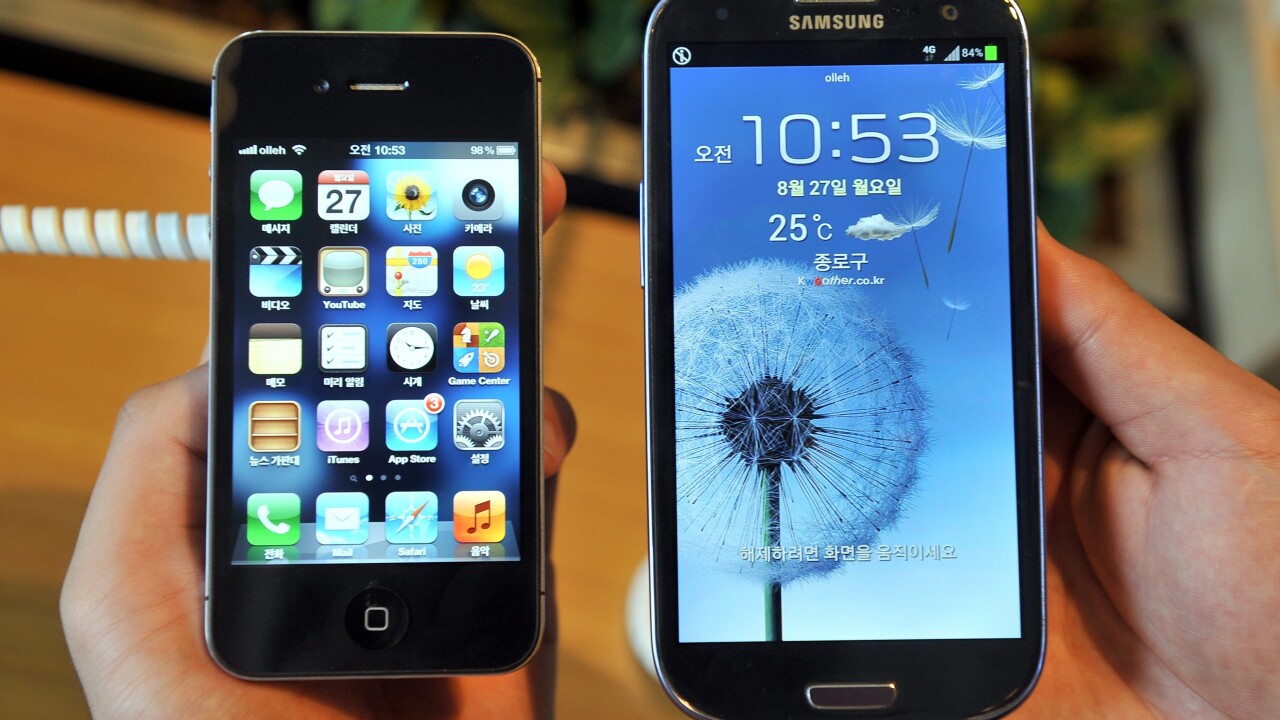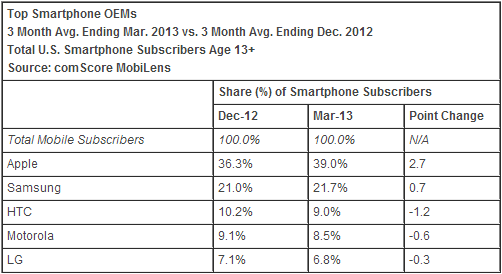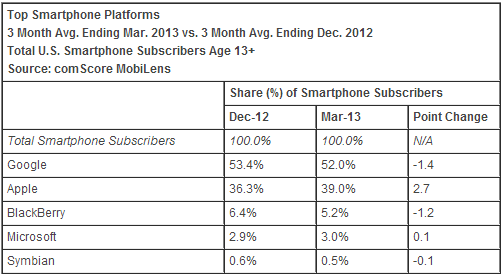
In the US, Apple dominated the first quarter of 2013 as the top smartphone OEM. Samsung is gaining as well, but not quite as quickly. Rounding out the top five are HTC, Motorola, and LG, all of which lost share in March.
In the platform space, Google is still first courtesy of Android, Apple is second with iOS, but the latter is gaining on the former. In fact, Apple’s gains in the hardware space have been so large recently that not only did iOS gain significantly, but Android has taken a hit for the third month running. Again, rounding out the top five are BlackBerry, Microsoft, and Symbian.
The latest data comes from comScore, which as usual surveyed over 30,000 mobile subscribers in the US. The analytics firm says 136.7 million Americans owned smartphones (58 percent mobile market penetration) in March, up 9 percent since December.
Between those three months, here is how the top five smartphones OEMs fared:
As you can see, Apple jumped 2.7 percentage points in terms of smartphone subscribers (from 36.3 percent to 39.0 percent) while Samsung gained 0.7 percentage points (from 21.0 percent to 21.7 percent). HTC dropped 1.2 points (from 10.2 percent to 9.0 percent), Motorola fell 0.6 points (from 9.1 percent to 8.5 percent), and LG dipped 0.3 points (from 7.1 percent to 6.8 percent).
Samsung and Apple gained a combined 3.4 points while the other three lost 2.1 points together. In other words, the duo continues to steal share from OEMs even not in the top five, at least in the US.
The iPhone 5 is definitely helping keep Apple ahead, as are older models of the company’s flagship product, but Samsung is nevertheless still managing to push forward. With the Galaxy S4 announced but not available till last month, we don’t expect Samsung to outgain Apple until April data shows up, and even then we’ll probably have to wait till May’s figures are out.
HTC’s continued losses don’t surprise us, and it seems that the company is pretty much betting everything on its One device. Just like with the S4, right now it’s hard to say if that’s a smart move. Google meanwhile still hasn’t figured out what to do with Motorola, and LG’s bleeding has restarted again, as Nexus 4 sales start to taper off.
For the first three months of 2013, the same trend continues in the US: Apple is beating everyone’s pants off, although Samsung is continue to grow share just fine. The figures suggest the tide will start to reverse soon, as it almost always does after a hot product from the Korean company.
On the software side, Google is still dominating but as of late Apple has started to make steady gains. Android has dropped for the third month in a row, and Microsoft has actually managed to gain share for the second time in a row:
Once again, Samsung’s gains are not enough to offset the losses of other Android makers. Google lost 1.4 percentage points between December and March (down from 53.4 percent to 52.0 percent). Apple meanwhile increased its share by 2.7 percentage points (moving from 36.3 percent to 39.0 percent, which happens to be identical to the figure for its smartphone share).
BlackBerry was down 1.2 points (from 6.4 percent to 5.2 percent), Microsoft gained 0.1 points (from 2.9 percent to 3.0 percent), and Symbian seems to have hit rock bottom at 0.5 percent. BlackBerry has only just celebrated its BlackBerry Z10 launch in the US while the Q10 isn’t yet available, so we won’t see an improvement till later as the company continues to be the biggest loser in these studies, month after month.
Microsoft’s second gain in a row is promising, but it’s too early to tell how much progress the company will be able to make. We don’t expect Google’s drop to continue (the One and S4 will likely bring a rebound).
In any case, the Android-iOS duopoly in the US has reached a new high: 91.0 percent market share. It can’t keep growing forever.
Top Image Credit: Jung Yeon-Je/Getty Images
Get the TNW newsletter
Get the most important tech news in your inbox each week.






